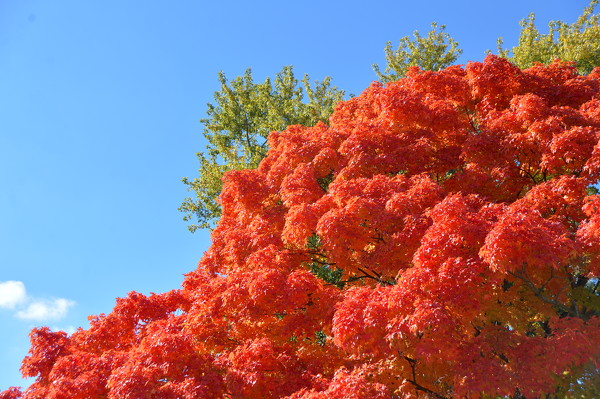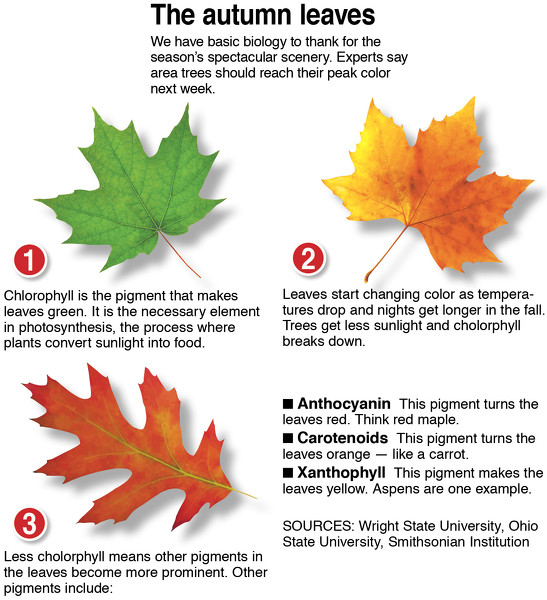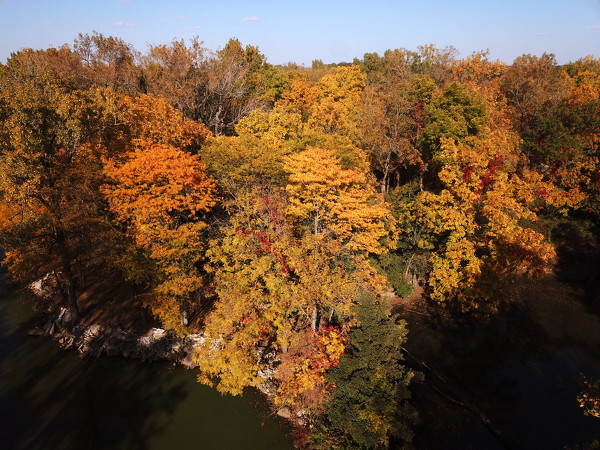Thursday, October 13th, 2022
Why leaves change color
Leaves should reach their peak colors soon
By Leslie Gartrell

Photo by Paige Sutter/The Daily Standard
This maple tree's leaves are burning with color.
In a final encore to summer, trees have started their annual colorful performance as leaves transition from their typical green hue to vibrant shades of red, orange and yellow.
The perfect time to see this symphony of color at its peak will be in the next week, according to Don Cipollini Jr., director of environmental sciences at Wright State University in Dayton.
Leaves begin to change color in the fall as days grow shorter and nights become longer and cooler, Cipollini said.
Cipollini said during the growing season of spring into early fall, trees are constantly creating chlorophyll, the key component in a plant's ability to turn sunlight into nutrients. Chlorophyll cells saturate leaves, ultimately reflecting the color green back to the eye, he said.
The longer and cooler nights of fall trigger changes in the tree, Cipollini said. The production of chlorophyll slows to a halt, eventually revealing the "true" color of the leaf, he said.

Photo by Bill Thornbro/The Daily Standard
We have basic biology to thank for the season's spectacular scenery. Experts say area trees should reach their peak color next week.
The two major compounds that give leaves their pigment are carotenoids and anthocyanins, Cipollini said. Carotenoid pigments are revealed when chlorophyll production stops, while anthocyanin pigments are produced by the tree, he said.
Common carotenoids found in plants include carotene, which gives carrots their orange coloring, and lycopene, which can be found in tomatoes.
"For example, red maple is named that because the leaves are quite red in the fall," he said. "Sugar maple, a relative, tends to be more yellow and orange in the fall. And then you have other species that turn yellow, like the ash tree… that simply is related to the different concentrations of the different carotenoids in their tissues."
Some trees, such as the dogwood, produce anthocyanins, Cipollini said. Anthocyanins produces rich hues of red, ranging from bright red to deep purple. Anthocyanins can be found in grapes, apples and cranberries.
Anthocyanins also protects the leaf from the bright sun and cool temperatures, prolonging its life on the tree through autumn, he said.
When leaves fall off the tree it is an intentional action, Cipollini said.
"The leaves falling off are a carefully controlled process by the plant," he said. "As (the tree) pulls back the nutrients it wants to store, it's slowly starting to shut off the transport to those leaves of water and sugars and thing the leaf needs to stay growing."

Photo by Ryan Snyder/The Daily Standard
Leaves explode with many colors near the Mercer County Sportsman Association in Celina.
An abscission layer seals the leaf from the tree, causing the leaf to dry up and wither until the wind blows and breaks it free of the plant, he said.
"For trees in the temperate zone, there's no sense of having leaves all winter long that just freeze. They can't do their job over the winter," he continued. "So the plant basically lets them pull back what it wants and needs out of those leaves, puts it into storage and then seals off the leaves and lets them break off and fall."
Once on the ground, leaves begin to break down and eventually return nutrients back to the ground, Cipollini said.
For those looking to take in this beautiful display of nature, there are numerous hiking, biking and walking paths in Mercer and Auglaize counties, as well as multiple nature preserves to take in the sights.
Jeni Bertke with the Greater Grand Lake Visitors Region suggested the Miami Erie Canal at Memorial Park in St. Marys, Windy Point State Park trail in Celina and the beaches along Edgewater Drive around Grand Lake at the state park in St. Marys.
Other prime viewing locations include the East Bank and West Bank trails in Celina, Kuffner Nature Preserve in St. Marys, the Celina-Coldwater bike path and Kuenning-Dicke Natural Area in New Bremen.







